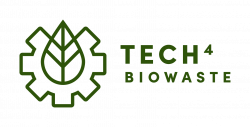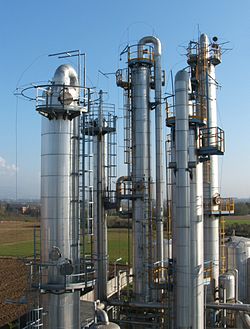Distillation
| Technology | |

| |
| Technology details | |
| Name: | Distillation |
| Category: | Pre-processing (Separation technologies), Post-processing (Separation technologies) |
| Feedstock: | all materials |
| Product: | separated products |
Distillation is the process of separating components or substances from a liquid mixture by using selective boiling and condensation. Distillation may result in essentially complete separation (nearly pure components), or it may be a partial separation that increases the concentration of selected components in the mixture. It is a physical separation process, not a chemical reaction. The application of distillation covers various options, for example purification of alcohol, desalination, crude oil refining, or making liquefied gases from air.
Feedstock
Origin and composition
Since distillation is limited for the use of liquid mixtures, the feedstock needs to be in liquid form. Examples in the field of biowaste here are fermented biowaste resources, as bioethanol, or bio oils. [1][2][3]
Pre-treatment
For a distillation, no specific pre-treatment is needed since it is used to separate different fraction within a process chain. To gain a liquid product from bio waste resources, fermentation or hydrothermal processing (hydrothermal liquefaction) are possible pre-treatment technologies.
Sometimes there are combination options with other technologies, such as extraction or esterification, for higher efficiencies.[1][2]
Process and technologies
Distillation exploits differences in relative volatilities of the feed mixture components. In a distillation column, a feed stream enters the middle of the column and two streams leave, one at the top and one at the bottom. Components with lower boiling points are concentrated in the stream leaving the top, while components with higher boiling points are concentrated in the stream leaving the bottom.
Separation is achieved by controlling the column temperature and pressure profiles to take advantage of differences in the relative volatility of the mixture components and therefore tendency to change phase. The lighter, lower boiling point components evaporate to the top of the column and the heavier, higher boiling point components condense to the bottom of the column.
This application is often referred to as rectification, which is a successive distillation. A simple distillation, as it can be seen below, is not typically used for industrial applications. In simple distillation, the vapor is immediately channeled into a condenser. As a result, simple distillation is effective only when the liquid boiling points differ greatly or when separating liquids from non-volatile solids or oils. For these cases, the vapor pressures of the components are usually different enough that the distillate may be sufficiently pure for its intended purpose.
The main advantages of rectification are that the system can be operated continuously through the refluxes and that the separation effect is many times greater than that of a simple distillation. The reason for this lies in the several countercurrent contacts of the vapor with the liquid. Therefore, rectification is preferred to sequential single distillations.
A plant that performs distillation is called a distillery. The apparatus used to perform distillation is called a still.
Products
With distillation two products are obtained. The product leaving the column at the top is referred to as distillate, while the product leaving at the bottom is referred to as bottom product or shortly bottoms.
Post-treatment
The post-treatment of the products depend on the next steps within the production chain. With distillation, it is not possible to completely purify a mixture of components, as this would require each component in the mixture to have a zero partial pressure. If ultra-pure products are the goal, then further chemical separation must be applied.
Technology providers
| Company name | Country | Technology subcategory | Technology name | TRL | Capacity [kg/h] | Processable volume [L] | Feedstock: Food waste | Feedstock: Garden & park waste |
|---|---|---|---|---|---|---|---|---|
| SULZER CHEMTECH | Switzerland | - | Distillation (continuous and batch distillation, single-stage and multi-stage distillation, extractive distillation, azeotropic distillation, pressure swing distillation, reactive distillation, divided wall columns) | 9 | - | - | ● | ● |
| TECHNOFORCETM | The Netherlands, India, Germany | - | Short Path Distillation / Molecular Distillation, fatty acid distillation, tocopherols distillation | 9 | - | - | ● | ● |
SULZER CHEMTECH
| General information | |||
| Company: | Sulzer Chemtech | 
| |
| Country: | Switzerland | ||
| Contact: | |||
| Webpage: | https://www.sulzer.com/en/shared/products/distillation | ||
| Technology and process details | |||
| Technology name: | Distillation (continuous and batch distillation, single-stage and multi-stage distillation, extractive distillation, azeotropic distillation, pressure swing distillation, reactive distillation, divided wall columns) | Technology category: | Pre-processing (Separation technologies), Post-processing (Separation technologies) |
| TRL: | 9 | Capacity: | kg·h-1 |
| Processable volume: | [L] | Other: | |
| Feedstock and product details | |||
| Feedstock: | Solutions | Product: | Distilled phases |
Sulzer Chemtech is a leading expert and solutions provider for a range of distillation technologies. Our product portfolio comprises a unique and extensive range of top-performance, state-of-the-art column internals:
- Structured packing (for example, MellapakPlus and BXPlus gauze packing)
- Random packing
- Trays (conventional, high performance and cartridge trays)
- Column internals (for example, distributors and collectors)
- Vapor-liquid and liquid-liquid phase separators (such as KnitMesh mist eliminators and MellachevronTM vane packs)
TECHNOFORCETM
| General information | |||
| Company: | TECHNOFORCE | ||
| Country: | The Netherlands, India, Germany | ||
| Contact: | sales@technoforce.net | ||
| Webpage: | https://www.technoforce.net | ||
| Technology and process details | |||
| Technology name: | Short Path Distillation / Molecular Distillation, fatty acid distillation, tocopherols distillation | Technology category: | Pre-processing (Separation technologies), Post-processing (Separation technologies) |
| TRL: | 9 | Capacity: | kg·h-1 |
| Processable volume: | [L] | Other: | Enhanced vacuum can lower boiling point by 100 to 150°C;
Heating temperatures up to 400°C; Pilot plants available in The Netherlands (Geleen) and India (Nashik) |
| Feedstock and product details | |||
| Feedstock: | Many, e. g. spent lube oil, natural waxes, fatty acids | Product: | Many, e. g. omega-3 fatty acids and glycerides, fine chemicals, silicone oils, and higher alcohols, re-refined spent lube oil, purified natural waxes |
Technoforce was started in 1990 to manufacture distillation and drying equipment based on Thin Film Technology. Other technologies like Extraction, Crystallization and Zero Liquid Discharge plants for industrial wastewater were added in later years. About 140 people are working in India and Europe in R&D, pilot plant testing, design and manufacturing.
Through in-house investments and cooperation with universities, Technoforce has developed synergistically relevant technologies. Thus, the customers can avail several process steps from a single source.
Having modern manufacturing facilities with robots and CNC machines in India and pilot plant facilities in India and The Netherlands, Technoforce has uniquely positioned itself to provide competitive solutions. We work very closely with the customers to assist in feasibility studies and tests in the pilot plants for process optimization.
Open access pilot and demo facility providers
Patents
Currently no patents have been identified.
References
- Distillation in Wikipedia
- Distilliation Fundamentals at Neutrium
- Distillation University of Utah
- ↑ a b Le Cao Nhien, Nguyen Van Duc Long, Sangyong Kim, Moonyong Lee, 2017-12: Techno-economic assessment of hybrid extraction and distillation processes for furfural production from lignocellulosic biomass. Biotechnology for Biofuels, Vol. 10, (1), 81. doi: https://doi.org/10.1186/s13068-017-0767-3
- ↑ a b Wan-Ting Chen, Yuanhui Zhang, Timothy H. Lee, Zhenwei Wu, Buchun Si, Chia-Fon F. Lee, 2018-11: Renewable diesel blendstocks produced by hydrothermal liquefaction of wet biowaste. Nature Sustainability, Vol. 1, (11), 702–710. doi: https://doi.org/10.1038/s41893-018-0172-3
- ↑ Alexandra Elena Plesu Popescu, José Lluis Pellin, Jordi Bonet, Joan Llorens, 2021-10-20: Bioethanol dehydration and mixing by heterogeneous azeotropic distillation. Journal of Cleaner Production, Vol. 320, 128810. doi: https://doi.org/10.1016/j.jclepro.2021.128810


